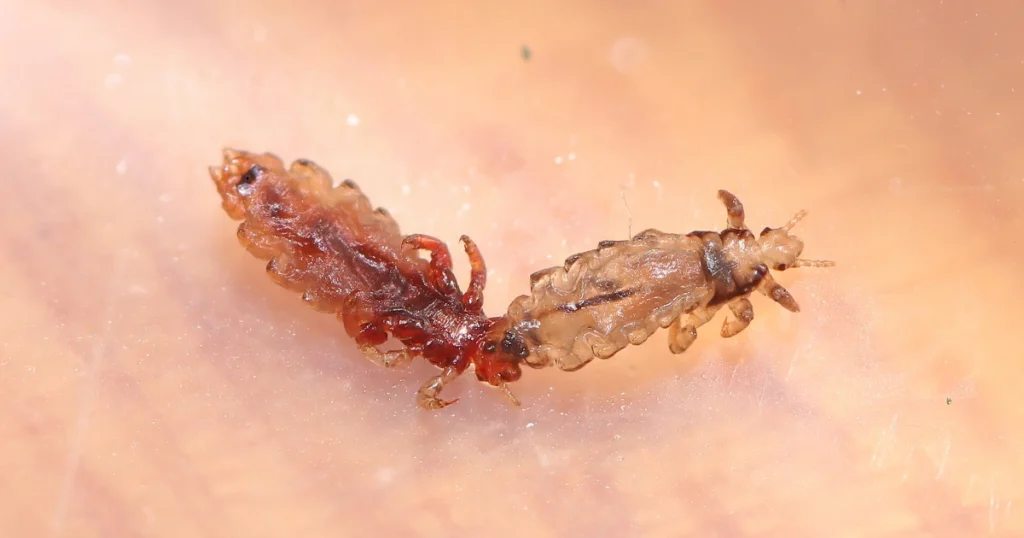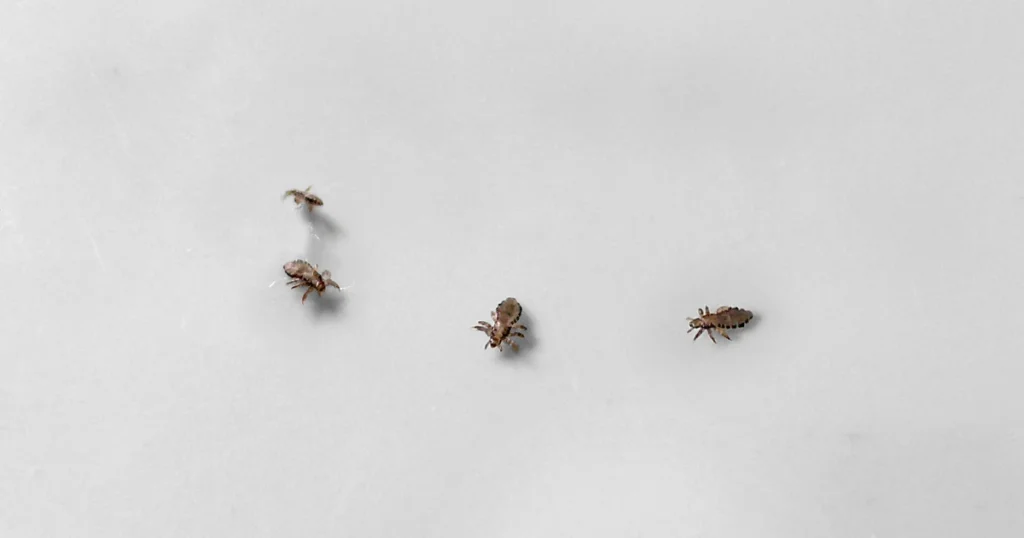Many pet owners worry about lice spreading from humans to dogs. But the good news is, it’s not possible. Humans and dogs have different types of lice, and they can’t switch hosts. Human lice need human blood, while dog lice need dog blood.
This means if you or someone in your home has lice, your dog won’t get them. It’s a relief for pet owners. So, even if there’s a lice problem at home, your dog is safe.

1-Understanding Dog Lice
To tackle dog lice infestations, it’s essential to start with the fundamentals of what dog lice are and how they affect dogs. Dog lice are ectoparasites that live on the fur and skin of dogs, causing discomfort and health issues.
What Are Dog Lice?

Dog lice are tiny, wingless insects that feed on the skin debris, secretions, or blood of dogs. They are species-specific, meaning they are adapted to live on dogs and are not typically transmitted to humans.
There are two main types of lice that affect dogs: chewing lice and sucking lice. Each type has distinct characteristics and feeding behaviors.
Types of Lice That Affect Dogs
Chewing lice, such as Trichodectes canis and Heterodoxus spiniger, have blunt, flat heads and survive by eating skin debris and surface secretions. T. canis is found worldwide and typically lives on a host for 30 days, while H. spiniger is more common in tropical regions.
Sucking lice, specifically Linognathus setosus, have sharp, pointed mouthpieces and feed on the dog’s blood. They are widespread in tropical and subtropical areas. Understanding the type of lice affecting your dog is crucial for effective treatment.


2-Can Dogs Get Lice from Humans?
As a dog owner, you might wonder if your pet can get lice from you or other family members. The good news is that the likelihood of dogs getting lice from humans is extremely low due to the species-specific nature of lice.
Species-Specific Nature of Lice
Lice are highly adapted to specific hosts, and the lice that infest humans are different from those that infest dogs. This species-specific nature means that human lice cannot survive or reproduce on dogs, and vice versa. The biological adaptations of lice to their specific hosts make it difficult for them to infest other species.
This specificity is due to the unique characteristics of the lice and their evolutionary adaptation to their hosts. As a result, the risk of transmission between humans and dogs is negligible.
How Dogs Actually Get Lice
Dogs can get lice through various means, primarily through direct contact with other infested dogs or animals. Lice have limited mobility; they can crawl but are unable to jump, hop, or fly. Therefore, close contact between dogs is a significant factor in the transmission of lice.
Other ways dogs can get lice include:
- Using grooming tools contaminated with lice or their eggs.
- Coming into contact with contaminated bedding or dog collars.
- Being in overcrowded housing or environments with poor sanitation.

Factors such as illness, malnourishment, stress, or age can also make dogs more susceptible to lice infestations. Understanding these transmission routes can help you take appropriate preventive measures to protect your dog.
3-Identifying Lice Infestations in Dogs
Detecting lice in your dog requires a keen eye for detail and an understanding of the signs to look out for. Lice infestations can manifest in various ways, making it crucial to be aware of both physical and behavioral changes in your dog.
Physical Signs to Look For
Physical signs of lice infestation in dogs include excessive scratching, biting, and rubbing against furniture or the floor. You may also notice tiny lice or their eggs (nits) attached to your dog’s hair, particularly around the ears, neck, and tail areas. Inspect your dog’s coat carefully, as these signs can be subtle.
Behavioral Changes in Infested Dogs
Dogs infested with lice may exhibit restless behavior, such as increased irritability and discomfort. They may also show changes in sleeping patterns due to constant irritation. Some dogs become more withdrawn or less playful, while others may become more aggressive or irritable when touched in areas where lice are causing discomfort. In severe cases, particularly in puppies or small dogs, anemia can occur due to blood loss from sucking lice, leading to decreased energy levels.
4-The Life Cycle of Dog Lice
Knowing the life cycle of dog lice helps in planning the right treatment approach. Dog lice infestations can be challenging to eliminate without a thorough understanding of their development stages.
From Eggs to Adults
The life cycle of dog lice consists of three main stages: eggs (nits), nymphs, and adults. Eggs are typically laid on the dog’s hair shaft and hatch into nymphs after a certain period. Nymphs go through several molts before becoming adult lice, which then continue the cycle by laying more eggs.
Why Understanding the Life Cycle Matters for Treatment
Insecticide treatments kill nymphs and adults but not eggs. Therefore, treatments must be repeated at strategic intervals, typically 7-10 days apart, for at least one month to break the life cycle completely.
| Treatment Stage | Purpose | Timing |
|---|---|---|
| Initial Treatment | Kill nymphs and adults | Day 1 |
| Follow-up Treatment | Kill newly hatched nymphs | Day 7-10 |
| Final Treatment | Ensure all lice are eliminated | Day 30 |
Understanding the life cycle of dog lice is crucial for effective treatment planning and execution. It ensures that all stages of the lice are targeted, preventing re-infestation.
5-Treating Dog Lice Infestations
Treating dog lice infestations requires a comprehensive approach that includes both medical treatment and environmental cleaning. To effectively eliminate lice, it’s essential to address both the infestation on your dog and the potential lice or eggs in your dog’s environment.
Effective Treatment Options
When it comes to treating dog lice, your veterinarian can recommend the most effective treatments, which may include medicated shampoos, sprays, or oral medications. It’s crucial to follow the treatment instructions carefully to ensure that you eliminate the lice completely.
Treatment Tips:
- Treat all dogs in a multi-dog household simultaneously to prevent reinfestation.
- Follow the treatment instructions provided by your veterinarian or the product label.
Cleaning Your Home and Dog’s Environment
Cleaning your home and your dog’s environment is a critical component of treating dog lice infestations. Lice can survive off a dog for a limited time, so it’s essential to thoroughly clean areas where your dog spends time.
| Area to Clean | Cleaning Method |
|---|---|
| Dog Bedding | Wash in hot water and dry on high heat. |
| Furniture and Carpets | Vacuum thoroughly, and consider using a steam cleaner. |
| Grooming Tools | Clean thoroughly, and consider replacing to prevent reinfestation. |
6-Preventing Lice in Dogs
To keep your dog safe from lice, take some simple steps. Good hygiene is key, and regular grooming is a must. This helps spot and stop lice early. Make sure to check your dog’s coat often and clean grooming tools after each use.
Washing your dog’s bedding in hot water helps keep lice away. Also, keep their sleeping spots clean. Avoid letting your dog near stray animals that might carry lice. Talk to your vet about using products that fight lice, fleas, and ticks. This will protect your dog and any cats you have.
Keeping your dog healthy is also important. Feed them well, take them to the vet regularly, and manage stress. This way, you can lower the chance of lice problems. It’s always better to prevent lice than to treat them.




